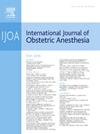美国分娩疼痛管理中的歧视、种族主义和偏见:研究和临床护理的范围回顾和方向
IF 2.6
3区 医学
Q2 ANESTHESIOLOGY
引用次数: 0
摘要
在美国,产科镇痛护理中的种族和民族差异仍然存在。目前缺乏有效的工具来衡量歧视、种族主义和偏见如何影响产科麻醉护理。因此,人们对种族主义和其他形式的歧视如何影响分娩过程中的疼痛管理知之甚少。在这篇范围综述中,我们评估了11项研究,这些研究定量地测量或定性地描述了美国分娩人群在分娩疼痛管理方面的歧视、种族主义或偏见。研究的重点是由于种族和民族、残疾状况、阿片类药物使用障碍史和健康保险状况而具有边缘化身份的分娩人群。我们提出了9项研究建议和14项临床实践建议,以减轻产科麻醉护理中人际、机构和结构歧视的影响。未来的研究应优先考虑结构性歧视与分娩疼痛管理之间的定量分析,并采用交叉方法改善对具有多重边缘身份的产妇的护理。临床实践建议包括在需要分娩镇痛之前与分娩人员建立融洽的关系和信任,使分娩和分娩人员多样化,建立患者-家庭咨询委员会,并鼓励专业协会倡导公平的围产期卫生政策。本文章由计算机程序翻译,如有差异,请以英文原文为准。
Discrimination, racism, and bias in childbirth pain management in the United States: a scoping review and directions for research and clinical care
Racial and ethnic disparities in obstetric analgesia care persist in the United States. There is a paucity of validated tools to measure how discrimination, racism, and bias affect obstetric anesthesia care. As a result, little is known about how racism and other forms of discrimination impact pain management during childbirth. In this scoping review, we evaluated 11 studies that quantitatively measured or qualitatively described experiences of discrimination, racism, or bias in childbirth pain management among birthing people in the United States. Studies focused on birthing people with marginalized identities due to race and ethnicity, disability status, history of opioid use disorder, and health insurance status. We provide nine recommendations for research and 14 recommendations for clinical practice to mitigate the impact of interpersonal, institutional, and structural discrimination in obstetric anesthesia care. Future research should prioritize quantitative analyses between structural discrimination and childbirth pain management, and employ an intersectional approach to improve care for birthing people with multiple marginalized identities. Clinical practice recommendations include developing rapport and trust with birthing people before labor analgesia is needed, diversifying the labor and delivery workforce, establishing patient-family advisory councils, and encouraging professional societies to advocate for equitable perinatal health policies.
求助全文
通过发布文献求助,成功后即可免费获取论文全文。
去求助
来源期刊
CiteScore
4.70
自引率
7.10%
发文量
285
审稿时长
58 days
期刊介绍:
The International Journal of Obstetric Anesthesia is the only journal publishing original articles devoted exclusively to obstetric anesthesia and bringing together all three of its principal components; anesthesia care for operative delivery and the perioperative period, pain relief in labour and care of the critically ill obstetric patient.
• Original research (both clinical and laboratory), short reports and case reports will be considered.
• The journal also publishes invited review articles and debates on topical and controversial subjects in the area of obstetric anesthesia.
• Articles on related topics such as perinatal physiology and pharmacology and all subjects of importance to obstetric anaesthetists/anesthesiologists are also welcome.
The journal is peer-reviewed by international experts. Scholarship is stressed to include the focus on discovery, application of knowledge across fields, and informing the medical community. Through the peer-review process, we hope to attest to the quality of scholarships and guide the Journal to extend and transform knowledge in this important and expanding area.

 求助内容:
求助内容: 应助结果提醒方式:
应助结果提醒方式:


